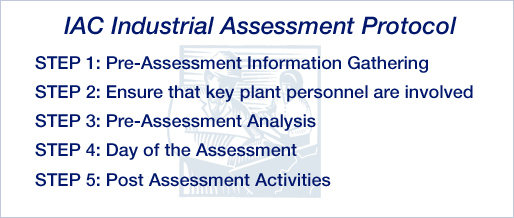Implementation Grant Funding Opportunity Open
IMPORTANT: The grant program operates on a rolling basis and applications may be submitted at any time, with quarterly reviews.
Learn More
Implementation Grant Funding Opportunity Open
Qualifying* small and medium-sized US manufacturers, that received IAC or Combined Heat and Power Technical Assistance Partnership assessments between 2018 and 2024, can now apply for grants for implementation of assessment recommendations up 50% of qualifying* project costs with a maximum of $300,000 per manufacturer.
IMPORTANT: The grant program now operates on a rolling basis and applications may be submitted at any time through the year, with quarterly reviews.
*See Full Grant Solicitation for full qualification and selection details.
The following guidelines are designed to describe the process of a typical IAC energy assessment center in the performance, creation and delivery of the primary products of the IAC program; the industrial assessment and the industrial assessment report.
Scope of Industrial Assessments
- The Industrial Assessment Center (IAC) is an energy center based in the engineering department of a major University, and supported by the Industrial Technologies Program at the US Department of Energy.
- The IAC team is comprised of one (or more) professors, and engineering students. One of these students is designated the report lead and another the safety lead.
- The typical IAC industrial assessment is expected to be conducted in one day.
- The resultant Assessment Report is designed to help medium sized manufacturers identify ways to save energy, reduce waste, and improve productivity while providing engineering students with hands-on training in manufacturing plants.

STEP 1: Pre-Assessment Information Gathering
Client is sent a Pre-assessment Form. This form includes:
- Size of Plant and plant layout
- Industry type (SIC/ NAICS code) and process description
- Production levels, units and dollars, operating hours
- A one year history of utility bills
- List of major energy consuming equipment
STEP 2: Ensure that key plant personnel are involved
- Plant manger
- Energy manager
- Environmental personnel
- Maintenance personnel
STEP 3: Pre-Assessment Analysis
- Analyze the manufacturing process
- Chart and graph utility bills
- Analyze utility bills for trends and errors; establish unit cost of energy
- Start Plant profile using QuickPEP
- Identify key energy systems
- Review design and other technical documentations
- Identify possible energy saving potential recommendations using IAC database
- Develop Assessment Day Strategy
STEP 4: Day of the Assessment
- Introduction
- History of the IAC program, ITP and BestPractices
- Distribute BP tools, case studies, tip sheets
- Description of manufacturing process and operations
- Is this a typical day?
- Run through process following material flow
- Discussion of inventory levels
- Questions about defects, bottle necks and waste materials
- Present charts and tables of utility bills
- Plant Tour
- Conduct in direction of the material flow
- Plant Manager to conduct tour
- Only one person will ask questions
- Conceptual tour, no data taken
- Meeting room debriefing
- Discuss process, ask questions
- Develop and plan for the afternoon
- Create specific tasks and divide into teams
- Review notes and brainstorm (Lunch)
- Develop list of potential energy saving opportunities
- Ensure that everyone has clarity of process and potential recommendations
- Refine List of opportunities to be investigated
- Decide what information needs to be gathered, measured, monitored
- Assign teams to specific tasks
- Make plans to meet at assigned time and place
- Data Gathering
-Conduct Measurements, monitoring and diagnostic testing- Motor systems
- Heat processes
- Cooling processes
- Water Use and pumps
- Ventilation
- Compressed Air
- Building Systems
- Delivery and distribution systems
- Exit Interview
- Discuss findings with management
- Prelimiary estimate of potential savings
- Prioritize recommendations of analysis
STEP 5: Post Assessment Activities
- Conduct engineering and financial analysis
- Develop first order estimates of implementation cost
- Deliver report to client, upload date to IAC database
- Contents of an IAC Report
- Executive Summary including summary of Recommendations
- Plant Description
- Process Description
- Resource Charts and Tables
- Major Energy Consuming Equipment
- Best Practices
- Description of Individual Energy Saving Recommendations
- Follow-up to Report
- Call client two week to ensure delivery and answer questions
- Call client in 6-9 months for implementation data
- Upload data to IAC database
- Inquire about potential for Case Study of project(s)

